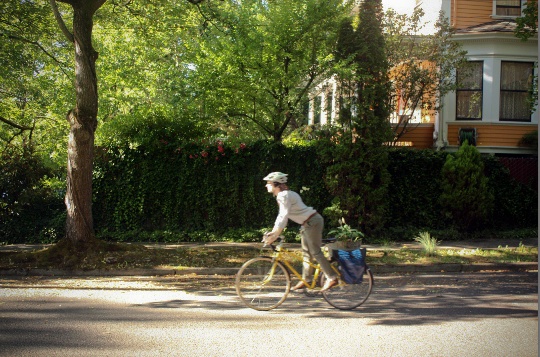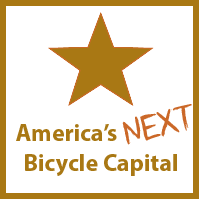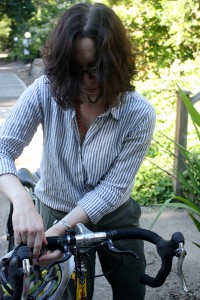
(Photos by L. Mitchell.)
Part of our series of guest posts, America’s Next Bicycle Capital, where we share community voices about the future of biking in Portland.
This week’s guest writer is Talia Jacobson, a transportation planner and ten-year Portland resident.
For those who sort the world by the four types of cyclists (the Myers-Briggs of bike advocacy), most indicators would mark me “enthused and confident.” I’ve been a full-time bike commuter for six years. I take lanes, haul groceries, and ride in just about any weather until ice gets involved. Run down the list of traits, and there’s only one place I break type: skill level.
I could legally vote before I learned how to ride. Years later, there are still days when I’m a slapstick routine on two wheels.
Getting people in the Portland area to travel by bike isn’t just a matter of building better infrastructure (important though that is). To really shift the needle, hundreds of thousands of us will need to make a choice to do something where our lack of skill is embarrassing, even hazardous, and stick with it long enough to get comfortable.
What does it take to make it as an adult novice cyclist? Allow me to share a few lessons from a decade spent trying not to fall down.
Lesson #1: If you don’t learn young, it can take a long time to get around to it. Here’s the short version of why I didn’t learn as a kid: my parents got me roller skates before I’d weaned myself off training wheels. I loved those skates. The bike collected dust till I outgrew it.
So what made me finally learn? In college, I signed up for a semester in Amsterdam, on a program requiring me to be able to ride a bike. Let me just say, there’s a particular combination of gratitude and humiliation you don’t know until you’re 20 and wobbling in circles around an empty parking lot, with your mom and your best friend snickering while they offer pointers. When I left for the Netherlands, one whole month of practice under my belt, I could get a bicycle upright and moving forward. Barely.
Lesson #2: You will fall down. You will mostly be ok. When you first learn to ride, going more than four miles an hour is terrifying. I spent my first weeks in Amsterdam creeping along, staring in dread at the next obstacle in my path, and either hitting it or wiping out in a last-minute effort to avoid it. I wasn’t just incompetent; I was a traffic hazard. Other cyclists and drivers had to swerve around me.
I improved, as anybody does when they spend every day sucking at something and doing it anyway. I got hooked on the thrill of biking around a city. Still, I kept falling. I wrapped my scarf around my cassette, Isadora Duncan style. I snagged my pants cuff on the crank arm and didn’t notice until I was shackled to my bike. Once, I tipped over during an ultra-low-speed turn and a dapper grandfather leapt off the sidewalk to rescue me. My learning curve was made of colorful bruises.
Advertisement
Lesson #3: The basics are more complicated than they seem. I spent years acquiring skills so fundamental that most people don’t think of them as skills. Things like: standing to climb a hill. Coasting down the other side without desperately clutching the brakes. Stepping off the seat and onto the ground when coming to a stop. Making a U-turn. Shifting in any remotely helpful way.
Yes, some people will learn faster, but I know from other novice friends that many don’t. (Shout out to Candy: glad the leg is healing.) I’ve probably picked up one or two tricks a year and still have more to go. If anyone can explain how the hell you a) ride downhill and b) signal in preparation for a turn that doesn’t require a stop while c) also braking, please comment. I’m still convinced this requires three hands.

Lesson #4: You will ride bad bikes because you won’t know what you’re missing. The first four bikes I rode were too small, the wrong proportions, and stupidly heavy, but I had no idea because I had no basis for comparison. Only after friends finally convinced me to upgrade to my first decent road bike did I understand how inadequate its predecessors had been.
When you ride bad bikes, it’s hard to tell a mechanical problem from overall slop in the system, so it takes forever to learn the signs that there’s a problem. This kind of thing makes you worse at biking than you actually are. I’ve ridden with everything from a slack chain to a broken axle just thinking my gears were cranky. The most recent time I rode a flat tire across the river? Last week.
Lesson #5: There are everyday ways other people can encourage you, or make you never want to ride again. This site’s full of great information about projects and programs that win over the interested-but-concerned, so I’m going to skip the wonky and focus on the personal. If you want my fellow bike novices to keep riding, here are easy ways to help:
- Teach. Casual instruction is hugely helpful, even in a city full of bike clinics and in the era of YouTube tutorials. Major thanks to all the friends who’ve taught me to patch flats, counterbalance turns, and find good bikes on Craigslist. The element of connection made the lessons stick.
- Ride courteously. Rudeness can be dangerous, and can lead some novices to stick the bike back in the garage indefinitely. I’ve taken falls flinching when another rider cut too close for comfort, and occasionally sent a newbie flailing after I pulled a maneuver that startled them. It doesn’t matter that you’re running late and the person wobbling along on a granny seat is slowing you down. Don’t be That Guy.
- Practice compassion. I owe a lot to the people who had great opportunities to treat me like an incompetent idiot and then didn’t. Friends who went on rides even though I was slower. Mechanics who didn’t roll their eyes when I didn’t know component names. The many, many strangers who’ve stopped to see if I was alright after a fall. You made me feel like it was okay not to be perfect.
Finally, for any newer rider who’s somehow found this post: I’ve been where you are, and I promise, you will get better. With time, you will ride faster, fall less, not get so sweaty, and pull moves that make you feel like a badass instead of like your life just flashed before your eyes.
The best argument for riding a bike? It’s incredibly fun. And the longer you keep at it, the more that will eclipse everything else.
If you’d like to add your voice to this series, get in touch via email: michael@bikeportland.org.



